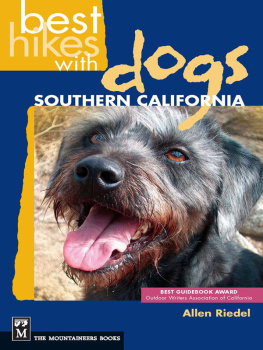ACKNOWLEDGMENTS
It was a delight to travel the Southern California coast and discover friendly hamlets and unexpected natural havens next to bustling beach communities. A warm thank-you to the friendly volunteers in visitor centers and the historical society and museum docents who were so eager to share information. We are grateful to park rangers, lifeguards, and campground hosts for their time in answering our many questions. Our dog Gem sends a shout out to all the business owners and their employees who made her feel so welcome and expressed their love for four-legged furry family members.
APPENDIX A
DAY HIKE CHECKLIST
YOU
Sturdy waterproof footwear for you and sandals for creek crossing and surf walking
Bug repellent in sealed plastic bag
Sunscreen
Sunhat and glasses
Layers for changing weather and rain-repelling windbreaker for fog and drizzle
Pocketknife (Swiss Armytype knife that includes additional tools)
Camera
POOCH
Collar, harness, leash, permanent ID tag with home/cell number
Flotation vest for safe water fun
Health and vaccination certificate
Flea and tick application prior to hike (topical and oral available from your veterinarian)
Collapsible water bowl and water supply in metal or plastic bottle32-ounce bottle for half-day hikes (under 4 hours) and 2-quart bottle for longer hikes. Eight ounces of water per dog per hour or 3 miles of hiking.
Kibbles for your dog at mealtimes on the trail and extra protein snacks for energy boost. Save the yummiest treats for recalls on voice-control trails and beaches.
Plastic resealable bags for carrying food, treats, medication, and first-aid essentials. The bags can be converted into food and water bowls as well as poop-scoop bags to carry waste out if necessary.
Biodegradable poop-scoop bags
YOU AND POOCH
First-aid kit (see appendix B)
APPENDIX B
TRAIL HAZARDS AND FIRST AID
BLEEDING FROM CUTS OR WOUNDS
Remove any obvious foreign object.
Rinse the area with warm water or 3 percent hydrogen peroxide.
Cover the wound with clean gauze or cloth and apply firm, direct pressure over the wound for about 10 minutes to allow clotting to occur and bleeding to stop.
Place a nonstick pad or gauze over the wound and bandage with gauze wraps (the stretchy, clingy type). For a paw wound, cover the bandaging with a bootie. (An old sock with duct tape on the bottom is a good bootie substitute. Use adhesive tape around the sock to prevent it from slipping off. Be careful not to strangle circulation.)
HEAT EXHAUSTION AND HEAT STROKE
Heat exhaustion occurs when humans or dogs bodies get too hot. On the trail it is commonly caused by too much physical exertion in hot weather and may be combined with dehydration. Human symptoms can involve heavy sweating, nausea, and headache. Heatstroke is more serious and occurs when human or dog body temperature rises quickly above 104 degrees F. In a dogs case, at this point panting is ineffective to regulate temperature. Dont put your dog at risk during hot weather.
In both human and dog cases, get out of the sun, rest in the shade, drink cool water, and apply water-soaked towels on the head (to cool the brain). Use any available body of water (a pond, lake, creek, ocean) to cool off and begin reducing body temperature (no lower than 103 degrees for dogs).
Avoid chilling your dog with icy water while cooling the chest, abdomen, and paws on dogs. Swabbing the footpads with alcohol will help.
HYPOTHERMIA
Hypothermia occurs when a humans body core temperature drops below 95 degrees F and your body is losing heat faster than it can produce it. Dogs normal core temperature is higher than humans (101 to 102.5), and they can become mildly hypothermic at just under 100 degrees. Southern California water ranges from 50s to low 70s depending on season and whether you are at the beach in Monterey County or San Diego County.
Just because dogs have fur doesnt mean they are immune to hypothermia. Certain breeds have a thicker fat layer for cold water, but overall any dog is vulnerable if in the water too long. Some dogs will keep running into the ocean for a ball as long as someone is throwing, just as easily as some dogs will run to exhaustion to keep up with their human. Be sensible and responsible. Dont risk your dogs life in the ocean.
Treatment for humans also applies for dogs:
Watch for signs of shivering; get him out of the water and wrap him in a blanket, towel, sleeping bag, your clothing, or whatever you have available.
Wrap him in warm towels from the dryer, or place warm water bottles in a towel next to him (bottles directly on the skin can burn).
Hold him close to you for body heat.
Have him drink warm fluids.
BUG BITES AND STINGS
Bee stings and spider bites may cause itching, swelling, and hives. If the stinger is still present, scrape it off with your nail or tweezers at the base away from the point of entry. (Pressing the stinger or trying to pick it from the top can release more toxins.) Apply a cold compress to the area and spray it with a topical analgesic like Benadryl spray to relieve the itch and pain. As a precaution, carry an over-the-counter anti-histamine (such as Benadryl) and ask your vet about the appropriate dosage before you leave, in case your dog has an extreme allergic reaction with excessive swelling.
RATTLESNAKE BITES
Keep victim (human or dog) calm (activity stimulates the absorption of venom).
Rinse the area with water, and transport victim (human or dog) to nearest medical aid.
SORE MUSCLES
Rest and massage limbs (human or dog).
Apply cold-water compresses to tight muscle areas to reduce inflammation.
Take over-the-counter aspirin-based anti-inflammatory (check with your physician); for your dog, Ascriptin buffered aspirin (check with your vet on dosage for your dogs age, breed, and weight).
SKUNKED
When your dog gets skunked, a potent, smelly cloud of spray burns his eyes and makes his mouth foam. The smell can make you gag, and contact with the spray on your dogs coat can give your skin a tingling, burning sensation. Apply de-skunking shampoo as soon as possible.
De-Skunking Shampoo Mix
1 quart hydrogen peroxide
cup baking soda
1 tablespoon dishwashing detergent
Put on rubber gloves and thoroughly wet your dog, apply mixture, and let stand for 15 minutes; rinse and repeat as needed.
CARDIOPULMONARY RESUSCITATION
Check with your veterinarian or local humane society for pet CPR classes.
FIRST-AID KIT CHECKLIST FOR YOU AND FIDO
YOU
First-aid book
Band-Aids
Technu soap or lotion to wash poison oak oil off skin
YOU AND FIDO
Hydrogen peroxide (3%) to disinfect surface abrasions and wounds
Antiseptic ointment
Gauze pads and gauze
Clingy and elastic bandages
Tweezers to remove ticks, needles, or foreign objects in a wound
Styptic powder for bleeding
Hydrocortisone spray to relieve plant rashes and stings
Instant Cold Packhelps reduce body temperature if you suffer from heat exhaustion or heatstroke and can save your dogs life if caught on a trail without water to cool your dog in the unfortunate event of heat exhaustion or heatstroke
FIDO
Muzzlethe most loving dogs can snap and bite when in pain. Muzzles come in different styles and sizes to fit all dog nose shapes.
Scissors (rounded tips) to trim hair around a wound.







![California Coastal Commission - California Coastal Access Guide [Lingua Inglese]](/uploads/posts/book/157220/thumbs/california-coastal-commission-california-coastal.jpg)
